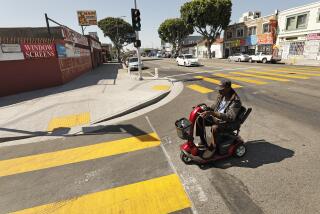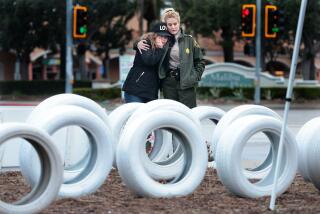Bike Lanes Are Tempting, but Joggers Should Stick to Sidewalks
- Share via
Dear Street Smart:
I ride my bike just about every morning and, inevitably, there will be joggers running against traffic in the bike lane, causing me to go into the car traffic lanes. Where I ride my bike, there are wide sidewalks that are never used.
It is difficult and dangerous to be riding at about 20 mph and simultaneously looking ahead, trying to avoid approaching obstacles, and looking over my shoulder to avoid getting run over by cars as I merge into their lane. It seems to be common sense that the bike lanes are for bikes and the sidewalks are for pedestrians.
Do the joggers belong on the sidewalks where it would be safer for everyone, or am I missing something?
David M. Ellis
Newport Beach
*
You’re not missing a thing, according to law enforcement officials. The California Vehicle Code expressly prohibits pedestrians--including joggers--from using a bike lane when “there is an adjacent adequate pedestrian” sidewalk.
Yet in the real world, said Ron Rodgers, a sergeant with the Newport Beach Police Department, it happens all the time. Why? “It’s much easier jogging on the roadway than the sidewalk,” said Rodgers, who jogs himself. “The asphalt is much softer than the concrete. That’s why I sometimes use the roadway instead of the sidewalk, but it doesn’t make it right.”
In practice, Rodgers said, most police officers ignore joggers in bike lanes if their presence isn’t creating a hazard, for example, if the lane is free of bicyclists or if there isn’t enough traffic in the adjacent car lane to make the situation dangerous.
If a bicycle collides with a car after swerving to avoid a jogger, however, the jogger is at fault and will be cited, Rodgers said.
His advice to runners: If you’re in a bike lane and a bicycle approaches, step aside.
*
Dear Street Smart:
I think a possible problem has been created with this new speed limit of 70 mph on interstate highways. The problem is that they have left the truck and car-with-trailer speed limit at 55 mph. This is a 15-mph speed differential.
That differential is too great.
With this spread of speed, accidents are possible. In Arizona, all vehicles move at the same speed. That is a far superior policy. What can be done to correct this; maybe raising the truck limit to 60 or 65 mph?
M. Lahr
Orange
*
In fact such a change was considered by state highway planners and rejected, according to Russell Snyder, a spokesman for Caltrans.
“We decided that trucks, by their very nature of being larger and less maneuverable, would remain at 55 mph,” Snyder said. “This was done with the advice and consent of the trucking industry, which agreed that 55 is a safe and prudent speed for large trucks.”
Similarly, Snyder said, Caltrans officials decided to retain the 55-mph limit for cars with trailers primarily for reasons of safety.
“Frequently, these are drivers who aren’t used to pulling trailers,” he said. “Maybe they’re on vacation and not all that familiar with their cars’ capabilities in pulling trailers.”
The speed differential between the slower and faster vehicles was not deemed hazardous, he said, because the roads on which the new 70-mph limit was posted are, for the most part, rural interstates.
“These are vast stretches of freeways where there are no onramps or offramps for a long time,” Snyder said. “You have plenty of time to see other vehicles coming. The speed differential isn’t a real issue here, as it is in urban areas where lots of decisions have to be made.”
*
Dear Street Smart:
I was informed, by someone who seemed to know, that it is against the law for trash and garbage trucks to drive on the freeways. I see these trucks on the freeway daily, so I believe he is wrong. Which is it?
J. Jessen
San Clemente
*
Your friend is indeed wrong. Garbage trucks have a right to be there, law enforcement officials say.
As long as they don’t spill any garbage, that is.
“Open containers have to be covered,” said Pat Ryan, a spokeswoman for the California Highway Patrol. “Littering is illegal; it’s unhealthy, it’s unsightly, it can cause accidents and it really bugs me.”
Most of the state’s garbage trucks, however, are clean.
“We haven’t had a lot of reports that they present any problem,” Ryan said.
More to Read
Sign up for Essential California
The most important California stories and recommendations in your inbox every morning.
You may occasionally receive promotional content from the Los Angeles Times.










